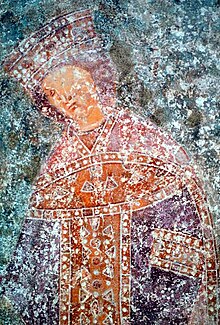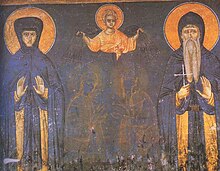Helen of Anjou
Helen of Anjou Јелена Анжујска Jelena Anžujska | |
|---|---|
 Portrait of Helen of Anjou, fresco inSerbian OrthodoxSopoćani Monastery | |
| Church Builder | |
| Venerated in | Eastern Orthodox Church |
| Attributes | Church Builder |
| Queen consort of Serbia | |
| Tenure | 1243–1276 |
| Born | c. 1235 |
| Died | 8 February 1314 (agedc. 78) Church of St. Nicholas,Skadar |
| Burial | |
| Spouse | Stefan Uroš I |
| Issue |
|
| Religion | Roman Catholic,thenSerbian Orthodox |
| Signature |  |
Helen of Anjou(Serbian Cyrillic:Јелена Анжујска,Jelena Anžujska,pronounced[jɛ̌lɛnaǎnʒuːjskaː];c. 1235 – 8 February 1314) was thequeen consortof theSerbian Kingdom,as the spouse of KingStefan Uroš I,who ruled from 1243 to 1276. Their sons were later Serbian kingsStefan Dragutin(1276–1282) andStefan Milutin(1282–1321). As a dowager-queen, she held the provincial governorship in the regions ofZetaandTravunija(until 1308). She builtGradac Monasteryand was known for herreligious tolerance.She is revered as a saint by theSerbian Orthodox Church.[1][2]Her relics, however, are now lost.
Life
[edit]
Origin
[edit]Helena's origin is not known for certain. Herhagiography,written by Serbian ArchbishopDanilo II(1324–1337), states only that she "was of a French family" (Serbian:бысть оть племене фpoужьскaаго), while later continuators of the same work noted that her "family was of royal or imperial blood".[3]
By the beginning of the 20th century, several genealogical theories on her origin were proposed, based mainly on examination of historical data related to Helena's sister Maria and her family, including Maria's husband Anselm, who was a high dignitary of theKingdom of Naples.[4][5]
One of those theories advocated that Helena was ofAngevineorigin.[6]That theory was based on free interpretation of some sources from the 1280s and 1290s, showing that Angevine kings of Naples referred to Queen Helen of Serbia asdear cousin.Based on that, some researchers started to advocate Helena's direct origin from the House of Anjou, coining the term "Helen of Anjou"(Jelena Anžujska). Despite a lack of supporting sources, the term became more popular during the 1920s and 1930s. It was promoted not only by journalists and publicists, but also by some scholars.
Stating that Helen was of French origin,John Fineassumed that she was "probably of theValoisfamily ".[7]
There was no doubt that Helena had a sister namedMaria,who was mentioned in several documents. In the summer of 1280, kingCharles I of Sicilyissued a document, allowing lady Maria to travel fromApuliato Serbia, to visit her sister, the queen of Serbia (Latin:Quia nobilis mulier domina Maria de Chaurs cum filio suo et familia eiusdem domine intendit transfretare ad presens ad partes Servie visura dominam reginam Servie sororem suam). In later documents, issued in 1281, Maria was mentioned by king Charles as his cousin (Latin:nobilis mulier Maria domina Chau consanguinea nostra carissima), and widow of Anselm "de Chau"(Latin:nobilem mulierem Mariam relictam quondam nobilis viri Anselmi de Chau).[8]
Gordon McDaniel proposed that Maria's husband Anselm "de Chau,who wasCaptain GeneralinAlbania(1273–1274) forCharles I of Naples,was the same person as Anselm "de Keu",who was mentioned in 1253–1254 as husband of Maria, daughter ofJohn Angelos of Syrmia.According to McDaniel, Maria and her sister Helen were descended, through their father John, from a side branch of theByzantine emperor's family, and theHungarian royal house.[9]
Parents of Maria Angelina are known from her marriage licenses, issued in 1253 and 1254 by the papal chancellery. The first mentions the marriage "inter Anselmum de Keu ac Mariam, natam Matildis dominae de Posaga, natae comitissae Viennensis",while the second mentions"Maria, nate quondam Calojohanni"and also mentions Maria's maternal uncle as"imperatore Constantinopolitano, eiusdem Matildis avunculo".Those data allowed McDaniel to identify Maria's father asJohn Angelos,lord ofSyrmia,and Maria's mother asMatilda,daughter ofHenry I, Count of ViandenandMargaret Courtenay(sister of the Latin emperorsRobertandBaldwin II).[10][11]
Family connections of Helen and her sister Maria have been a special subject of several genealogical and historical studies that tried to resolve questions related to prosopography of various royal and noble families, including some complex questions related to Maria's husband by attribution of sources on (at least) two persons (father and son) who had the same name:Anselm de Cayeux.[12][13][14][15][16]
Queen of Serbia
[edit]
Helen married KingStefan Uroš I of Serbia(1243–1276), around 1245–1250. In 1276, conflict broke out between her husband and their eldest sonStefan Dragutin.[17]King Uroš abdicated, and later died in 1280. During the reign of her sons Stefan Dragutin (1276–1282) andStefan Milutin(1282–1321), dowager-queen Helen held provincial administration in the regions ofZetaandTravunia,until 1308. She proved to be a successful administrator, governing regions with mixedSerbian OrthodoxandRoman Catholicpopulation.[18][19]
Soon after that, she became anunat the Church ofSt. NicholasinSkadar,where she died on 8 February 1314.[20]She wascanonizedby theSerbian Orthodox Church.Herfeast dayis 12 November [O.S.30 October].

Queen Helen significantly contributed to the cultural rise of the medieval Serbian state. She had a library at her court and encouraged transcription of books in monasteries. She founded the first girls' school in medieval Serbia. One of Helen's palaces was in the town ofBrnjak(sometimes called "Brnjaci" ) in the territory of modernKosovo.She also possessed the town ofJelečatRogoznamountain. As did other members of theNemanjić dynasty,she built monasteries and donated to churches. She built theGradac Monastery,where she was buried, the Church of St. Nicholas inSkadarwhere she died, and renewed theMonastery of Saints Sergius and Bacchus.She had repaired and rebuilt many churches and monasteries aroundLake Skadarthat had been devastated by theMongol invasion of 1242.[4][21][22][23]
Issue
[edit]Queen Helen and her husband, King Stefan Uroš I, had at least three children:
- Stefan Dragutin,Serbian king 1276–1282
- Stefan Milutin,Serbian king 1282–1321
- Brnjača,daughter
See also
[edit]References
[edit]- ^Fine 1994,pp. 217, 220–221, 258–259.
- ^Ćirković 2004,pp. 49, 58, 61.
- ^Даничић 1866,p. 58.
- ^abМијатовић 1903,pp. 1–30.
- ^Jireček 1911,p. 319.
- ^Веселиновић 1909,p. 184.
- ^Fine 1994,pp. 220, 258.
- ^Petrovitch 2015,p. 171.
- ^McDaniel 1984,p. 48–49.
- ^McDaniel 1984,p. 43.
- ^McDaniel 1986,p. 196.
- ^McDaniel 1984.
- ^McDaniel 1986.
- ^Angold 2011.
- ^Petrovitch 2015.
- ^Bácsatyai 2017.
- ^Ćirković 2004,p. 49.
- ^Fine 1994,p. 217.
- ^Ćirković 2004,pp. 49, 61.
- ^Petrovitch 2015,p. 168.
- ^Samardžić & Duškov 1993,pp. 96, 100.
- ^Ivić 1995,pp. 59, 75, 109.
- ^Bataković 2005,pp. 26–27, 31.
Sources
[edit]- Angold, Michael(2011). "The Latin Empire of Constantinople, 1204–1261: Marriage Strategies".Identities and Allegiances in the Eastern Mediterranean after 1204.Farnham: Ashgate Publishing Limited. pp. 47–68.ISBN9781409410980.
- Bácsatyai, Dániel (2017)."A 13. századi francia–magyar kapcsolatok néhány kérdése"(PDF).Századok.151(2): 237–278.
- Bataković, Dušan T.,ed. (2005).Histoire du peuple serbe[History of the Serbian People] (in French). Lausanne: L’Age d’Homme.ISBN9782825119587.
- Ćirković, Sima(2004).The Serbs.Malden: Blackwell Publishing.ISBN9781405142915.
- Даничић, Ђура,ed. (1866).Животи краљева и архиепископа српских[Lives of Serbian Kings and Archbishops] (in Serbian). Загреб.
{{cite book}}:CS1 maint: location missing publisher (link) - Fine, John Van Antwerp Jr.(1994) [1987].The Late Medieval Balkans: A Critical Survey from the Late Twelfth Century to the Ottoman Conquest.Ann Arbor, Michigan: University of Michigan Press.ISBN0472082604.
- Ivić, Pavle,ed. (1995).The History of Serbian Culture.Edgware: Porthill Publishers.ISBN9781870732314.
- Jireček, Constantin(1911).Geschichte der Serben.Vol. 1. Gotha: Perthes.
- Jireček, Constantin(1918).Geschichte der Serben.Vol. 2. Gotha: Perthes.
- Mazzoleni, Jole, ed. (1967) [1952].I registri della Cancelleria Angioina(PDF).Vol. 4 (2nd ed.). Napoli: Accademia Pontaniana.
- Мијатовић, Чедомиљ(1903)."Ко је краљица Јелена?".Летопис Матице српске.217:1–30.
- McDaniel, Gordon L. (1984)."On Hungarian-Serbian Relations in the Thirteenth Century: John Angelos and Queen Jelena"(PDF).Ungarn-Jahrbuch.12 (1982-1983): München, 1984: 43–50.
- McDaniel, Gordon L. (1986). "The House of Anjou and Serbia".Louis the Great: King of Hungary and Poland.Boulder: East European Monographs. pp. 191–200.ISBN9780880330879.
- Nicol, Donald M.(1993) [1972].The Last Centuries of Byzantium, 1261-1453.Cambridge: Cambridge University Press.ISBN9780521439916.
- Petrovitch, Nicolas (2015)."La reine de Serbie Hélène d'Anjou et la maison de Chaources".Crusades.14(1): 167–182.doi:10.1080/28327861.2015.12220366.ISBN9781472468413.S2CID257002925.
- Stevanović, Miladin (2004).Kraljica Jelena Anžujska.Knjiga-komerc.ISBN9788677120320.
- Miodrag Al Purković (1956).Princeze iz kuće Nemanjića.AV ALA printing and publishing.
- Samardžić, Radovan;Duškov, Milan, eds. (1993).Serbs in European Civilization.Belgrade: Nova, Serbian Academy of Sciences and Arts, Institute for Balkan Studies.ISBN9788675830153.
- Веселиновић, Милојко (1909)."Српске калуђерице".Глас Српске краљевске академије.80:155–256.
External links
[edit]- 13th-century Serbian royalty
- 14th-century Serbian royalty
- 14th-century Serbian women
- 14th-century Christian saints
- Capetian House of Anjou
- Nemanjić dynasty
- Medieval Serbian royal consorts
- 14th-century Serbian nuns
- Converts to Eastern Orthodoxy from Roman Catholicism
- 1230s births
- 1314 deaths
- Christian female saints of the Middle Ages
- Burials at Serbian Orthodox monasteries and churches
- 13th-century Serbian nuns
- Eastern Orthodox royal saints
- Serbian saints of the Eastern Orthodox Church
- Queens consort of Serbia
- Queen mothers
- Mothers of Serbian monarchs


